
Lombok is an island in West Nusa Tenggara province, Indonesia. It forms part of the chain of the Lesser Sunda Islands, with the Lombok Strait separating it from Bali to the west and the Alas Strait between it and Sumbawa to the east. It is roughly circular, with a "tail" to the southwest, about 70 kilometres across and a total area of about 4,607.38 square kilometres including smaller offshore islands. The provincial capital and largest city on the island is Mataram.

Sumbawa is an Indonesian island, located in the middle of the Lesser Sunda Islands chain, with Lombok to the west, Flores to the east, and Sumba further to the southeast. Along with Lombok, it forms the province of West Nusa Tenggara, but there have been plans by the Indonesian government to split the island off into a separate province. Traditionally, the island is known as the source of sappanwood, as well as honey and sandalwood. Its savanna-like climate and vast grasslands are used to breed horses and cattle, as well as to hunt deer.

East Nusa Tenggara is the southernmost province of Indonesia. It comprises the eastern portion of the Lesser Sunda Islands, facing the Indian Ocean in the south and the Flores Sea in the north. It consists of more than 500 islands, with the largest ones being Sumba, Flores, and the western part of Timor; the latter shares a land border with the separate nation of East Timor. The province is subdivided into twenty-one regencies and the regency-level city of Kupang, which is the capital and largest city.

West Nusa Tenggara is a province of Indonesia. It comprises the western portion of the Lesser Sunda Islands, with the exception of Bali which is its own province. The province's land area is 19,931.45 km2. The two largest islands by far in the province are the smaller but much more populated Lombok in the west and the much larger in area but much less densely populated Sumbawa island in the east. Mataram, on Lombok, is the capital and largest city of the province. It shares maritime borders with Bali to the west and East Nusa Tenggara to the east.

Tourism in Indonesia is an important component of the Indonesian economy as well as a significant source of its foreign exchange revenues. Indonesia was ranked at 20th in the world tourist Industry in 2017, also ranked as the ninth-fastest growing tourist sector in the world, the third-fastest growing in Asia and fastest-growing in Southeast Asia. In 2018, Denpasar, Jakarta and Batam are among of 10 cities in the world with fastest growth in tourism, 32.7, 29.2 and 23.3 percent respectively. The tourism sector ranked as the 4th largest among goods and services export sectors.
Ikat is a dyeing technique from Indonesia used to pattern textiles that employs resist dyeing on the yarns prior to dyeing and weaving the fabric. The term is also used to refer to related and unrelated traditions in other cultures. In Southeast Asia, where it is the most widespread, ikat weaving traditions can be divided into two general clades. The first is found among Daic-speaking peoples. The second, larger group is found among the Austronesian peoples and spread via the Austronesian expansion. Similar dyeing and weaving techniques that developed independently are also present in other regions of the world, including India, Central Asia, Japan, Africa, and the Americas.
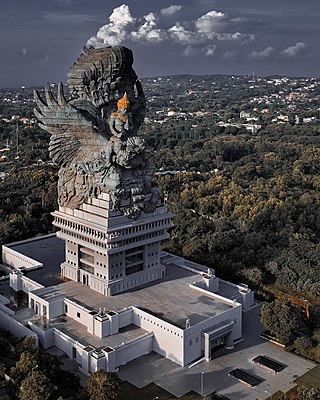
The culture of Indonesia has been shaped by long interaction between original indigenous customs and multiple foreign influences. Indonesia is centrally-located along ancient trading routes between the Far East, South Asia and the Middle East, resulting in many cultural practices being strongly influenced by a multitude of religions, including Buddhism, Christianity, Confucianism, Hinduism, and Islam, all strong in the major trading cities. The result is a complex cultural mixture, often different from the original indigenous cultures.
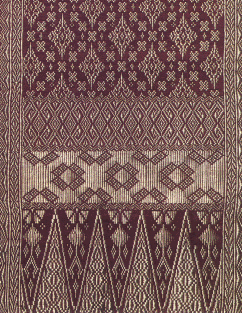
Songket or sungkit is a tenun fabric that belongs to the brocade family of textiles of Brunei, Indonesia, Malaysia, and Singapore. It is hand-woven in silk or cotton, and intricately patterned with gold or silver threads. The metallic threads stand out against the background cloth to create a shimmering effect. In the weaving process the metallic threads are inserted in between the silk or cotton weft (latitudinal) threads in a technique called supplementary weft weaving technique.

Sail Indonesia is a series of sailing and other events for yachts conducted each year in Indonesia. The events are organised by Yayasan Cinta Bahari Indonesia (YCBI) and supported by the high-profile tourist destinations to international yachtsmen and women with a view to expanding the tourism potential and raising awareness of the region as well as introducing visitors to natural and cultural features of the Indonesian archipelago that they might otherwise not visit.

Tais is a form of Tenun weaving tradition native to the eastern Indonesian regions of the Maluku Islands, the Tanimbar Islands, and the East Nusa Tenggara Islands. It has become an essential part of people in the eastern Indonesia hemisphere region, which mainly used for ceremonial adornment, sign of respect and appreciation towards guests, friends, relatives, home decor, and personal apparel.

Central Lombok Regency is a regency of the Indonesian Province of West Nusa Tenggara. It is located on the island of Lombok and the capital is Praya. It covers an area of 1,208.39 km2, and had a population of 859,309 at the 2010 census and 1,034,859 at the 2020 census; the official estimate as at mid 2023 was 1,099,211.

Kodam IX/Udayana is a military regional command of the Indonesian Army which is responsible for the Lesser Sunda Islands. It was established as part of the 1985 reorganisation of the Indonesian National Armed Forces (TNI) and included East Timor until that province achieved independence in 1999.

The national costume of Indonesia is the national attire that represents the Republic of Indonesia. It is derived from Indonesian culture and Indonesian traditional textile traditions. Today the most widely recognized Indonesian national attires include batik and kebaya, although originally those attires mainly belong within the island of Java and Bali, most prominently within Javanese, Sundanese and Balinese culture. Since Java has been the political and population center of Indonesia, folk attire from the island has become elevated into national status.

It is quite difficult to define Indonesian art, since the country is immensely diverse. The sprawling archipelago nation consists of 17.000 islands. Around 922 of those permanently inhabited, by over 1,300 ethnic groups, which speak more than 700 living languages.

The Abui are an indigenous ethnic group residing on Alor Island, East Nusa Tenggara, Indonesia. Abui people are spread across the districts of South Alor, East Alor, and Northwest Alor in Alor Regency. Abui people speak the Abui language, which is a Papuan (non-Austronesian) language, as well as Indonesian, and a Malay-based creole known as Alor Malay.

Putri Indonesia 2018, the 22nd Puteri Indonesia pageant, was held on March 9, 2018 at Jakarta Convention Center, Jakarta, Indonesia. Bunga Jelitha, Puteri Indonesia 2017 of Jakarta SCR 5, crowned her successor, Sonia Fergina Citra of Bangka Belitung, at the end of the event. She defeated 38 other candidates to win the title of Miss Universe Indonesia 2018 and represented Indonesia at Miss Universe 2018, where she placed as one of the Top 20 finalists.
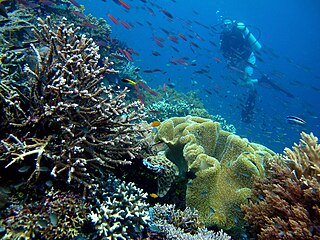
Eastern Indonesia is one of the two main geographical regions of Indonesia, the other being Western Indonesia. Eastern Indonesia spans across the Banda and Maluku Seas in the west, the Arafura and Timor Seas in the south, and the Halmahera Sea in the north. It comprises the archipelagic territory of Tanimbar, Banda, Maluku, Halmahera, Raja Ampat, Biak, and Western New Guinea. Central Indonesian Time and Eastern Indonesia Time are the national standard time designated for Eastern Indonesia; it falls within the UTC+8 and UTC+9 time zone, respectively.
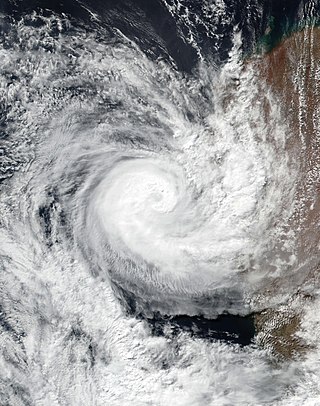
Severe Tropical Cyclone Seroja was the third-deadliest tropical cyclone on record in the Australian region, behind Cyclone Mahina in 1899 and the Flores cyclone in 1973. Seroja brought historic flooding and landslides to portions of southern Indonesia and East Timor and later went on to make landfall in Western Australia's Mid West region, becoming the first to do so since Cyclone Elaine in 1999. The twenty-second tropical low, seventh tropical cyclone, and third severe tropical cyclone of the 2020–21 Australian region cyclone season, the precursor of Seroja formed off the south coast of Timor island as Tropical Low 22U at 18:00 UTC on 3 April 2021; its genesis was related to convectively coupled equatorial waves. The tropical low moved very slowly near the island, while the system's thunderstorms increased in organization. The low intensified into Tropical Cyclone Seroja by 4 April, while it was passing north of Rote Island, while continuing its slow strengthening trend.
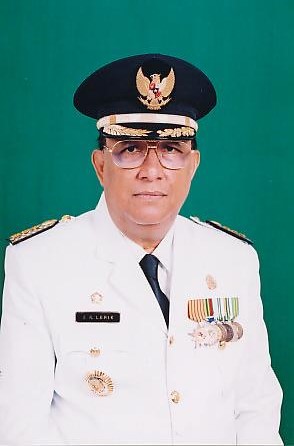
Samuel Kristian Lerik was an Indonesian military officer, bureaucrat, and politician who served as the mayor of Kupang from 1986 until 2007.

















